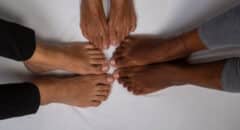
As the year comes to a close, millions of Americans, are thinking about resolutions for the New Year—eating healthier, getting in shape, and taking better care of themselves. But if they don’t take the right approach by February many will experience resolution dissolution. Most people fail at diet and lifestyle resolutions because they set unrealistic goals and lack support as they strive to improve their health.
As a Certified Diabetes Educator, I know first-hand that living with diabetes is challenging. Every day you must make choices that will affect your diabetes and your life: monitor your blood glucose (BG), take your medication, inject your insulin, read food labels, find time to exercise, put down the donut, check your weight, check your feet and hide the salt shaker. And you have to make those choices again tomorrow and the next day and the next. Moreover, most of the time the choices you make to improve your health go unnoticed.
In fact, according to a recent survey from LifeScan, Inc., the makers of the OneTouch Verio Flex® blood glucose monitoring system, over half of patients with diabetes agreed they often felt alone in their diabetes management. And, if a family member, friend or healthcare provider recognized their everyday effort in managing their diabetes, it would motivate them to continue their efforts to live a healthier lifestyle. Recognition is a simple thing. It could come in the form of a "good job!" or a hug, maybe even a high five. That high five can make all the difference – even if it's for something seemingly small and insignificant.
That’s because small changes lead to big success, and I am a firm believer that success breeds success. It’s incredibly important to empower people with diabetes to continue making small changes in their daily lives.
What Are Small Changes?
A small change is exactly as it sounds – something gradual that you can build upon over time. It doesn’t mean you should plan to run a marathon tomorrow or drastically change your diet in a day. Start with setting small, achievable goals that you can stick with. Once you start reaching or surpassing them, set even higher ones! Soon enough, you’ll see how all those small changes add up.
So what are some examples?

- Get A Good Night’s Sleep
Adults are estimated to spend approximately one-third of their lives sleeping, which means it’s very important! And sleep deficiency has been linked to several diseases, including diabetes. Think twice before choosing to binge-watch an entire Netflix series before going to sleep and instead plan to go to bed a little bit earlier. The extra sleep will make you feel more energized, elevate your mood, and can even help maintain your weight.
- Monitor Your Blood Glucose Levels
Blood glucose testing with meters is a great way to help you see how the moments and the choices you make add up – one good reading leading to another. This form of testing is still the most accurate and cost-effective way to track your BG. You can also use meters that connect to apps so you can share your progress with your loved ones and healthcare providers.
- Stick to Recommended Meal Portions
Sometimes it’s hard not to overindulge – and I say that from personal experience! But a great small victory to tackle is to eat your meals in their recommended portions. That means try to have 2 tablespoons of peanut butter instead of the whole jar.
But most importantly, accentuate the positive. Give yourself credit for positive health behaviors. Overeating at one meal doesn’t translate into “diet failure.” Think about it: if you eat three meals every day that’s 21 meals a week, right? So if you have a dietary “indiscretion” at one or two of those meals, that still translates into 19 or 20 meals that were balanced and healthy. That’s a cause for celebration.
- Take the Stairs
Start by making small gradual changes in your health habits. If you haven’t walked on the treadmill in months, it’s not reasonable to think that you’ll be able to jog for an hour. Instead, tell yourself you’ll do 10 minutes.
Or start off by simply opting to walk up the stairs instead of taking the elevator. Start off small by taking the elevator to one floor below your destination – then walk the rest of the way! Over time, you can walk more and more flights of stairs until soon enough, you don’t need to use the elevator at all. As you get stronger and increase your stamina, you can do a little more, then a little more. Over time, you’ll reach your fitness goal.
- Try A New Exercise Class
If you’ve gone to a certain exercise class before and didn’t enjoy it – don’t discount the rest of them! Just because one form of exercise did not work for you doesn’t mean there isn’t something you’d enjoy. For example, yoga is very different from cycling. If you’ve sworn off all fitness classes, how about giving something completely different a try? You might be avoiding your new favorite hobby.
Always speak with your doctor before you make any changes to diet, exercise or diabetes management routine; it’s important to have an open dialogue with your care team about your diabetes management.
Finally, think about your diabetes management goals, write down three small changes you’ll make this year, post it on the fridge and reference it often. Seeing those goals written down will be a reminder to keep on track. Remember, it’s okay if you veer off course. If you do, readjust and celebrate the #SmallVictories along the way. I encourage you to share a positive word on social media or via text or phone today. Your success will motivate and empower others living with diabetes to continue their efforts in living well with diabetes. Share your #SmallVictories by tagging OneTouch on Twitter or commenting in their Facebook feed.
 Constance Brown-Riggs, MSED, RD, CDE, CDN is a registered dietitian, certified diabetes educator, national speaker and author of The African American Guide to Living Well with Diabetes. Her new book “Diabetes Guide to Enjoying Foods of the World” will be released in January 2018. She is a spokesperson for OneTouch.
Constance Brown-Riggs, MSED, RD, CDE, CDN is a registered dietitian, certified diabetes educator, national speaker and author of The African American Guide to Living Well with Diabetes. Her new book “Diabetes Guide to Enjoying Foods of the World” will be released in January 2018. She is a spokesperson for OneTouch.









